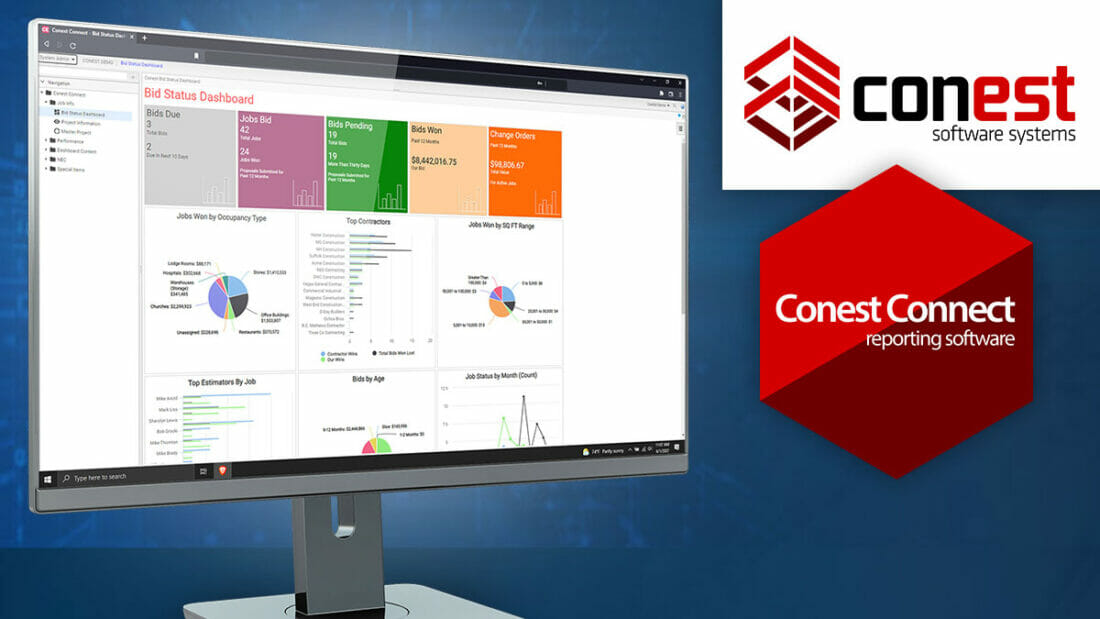From The Field: Conest Connect – What I’ve Always Been Looking For
Article written by: Stephen Carr
At my second job as an electrical estimator, a management consultant advised that I start keeping a log of my estimates. He said I should record who won the project, the winning general contractor, my price, the winning price, my square foot price and the winner’s square foot price. Also, if I won the project, record things such as your final cost and profit levels. At first, I recorded this information in a logbook, but I soon switched to a simple database program called dBase. Finally, I switched to a spreadsheet when they became more powerful. I continued to keep bid records the entire time I estimated as an employee. Since becoming a consultant, I recommend to all my customers they do the same.
While time consuming, this record keeping is very important. By maintaining and studying your bid records, you can fine tune your bidding in many ways. Here are a few examples.
Am I bidding the right kind of work?
You can easily see trends that allow you to select the right kinds of jobs to bid. For instance, your analysis may show you are making considerably more profit on commercial tenant improvement work when compared to new school projects.
Am I bidding to the right people?
When studying your records, you may find your success rate with a certain customer is a lot better than with other customers. By studying my bid records, I became aware of which general contractors were shopping my numbers to my competition.
Need a budget price?
When working as an employee for electrical contractors, I often received requests for preliminary budgets from general contractors and owners. I saved many hours of work by going into my bid records to find the cost information for similar projects. I could often use a square foot price, adjust for inflation, and have a budget done in an hour.
Enter Conest Connect
Connect is a complete bidding management tool, from conception to completion, including record keeping and analysis. This product completely replaces my spreadsheet and adds capabilities my spreadsheet never had.
A few weeks ago, I participated in an online demonstration. For my demonstration, the program opened up to a Bid Status Dashboard, which pulls a lot of data from your Conest IntelliBid estimate file, thereby eliminating having to do data entry twice. The dashboard can be modified by the user to display the data in which they are most interested. The demonstration dashboard included five tiles at the top, including Bids Due, Jobs Bid, Bids Pending, Bids Won and Change Orders. The tiles present a summary of the associated information. Clicking on a tile takes you to the details the tile’s summary comes from. The project information is presented in a list format, with 1 row per project. The columns include dozens of titles such as Job Name, Bid Due Date, Submit Date, Square Feet, Bid Total and many more. The columns can be customized to fit the user’s preferences. The project information list is completely interactive, allowing the user to sort, filter, drill down to more detailed information, and make changes to the information as needed.
The Dashboard also displayed graphs for Bids Won By Occupancy, Top Contractors (General Contractors), Jobs Won By Square Foot, Top Estimators By Job, Bids By Age, Job Status by Month, Top Contractors by Revenue and Competitor’s Performance. Similar to the tiles, the graphs can be clicked on to access the data from which they came. Graphs can be created from just about any of the data available to the program.
Another feature is a more in-depth analysis of performance by estimators, contractors, and competitors. In particular, the contractor and competitor analysis are very important to me. As I mentioned above, success as an estimator and a contractor is very dependent on knowing what your customers and competitors are doing. Are you being treated fairly? Are your numbers being shopped? Which of your competitors are getting the work? These and many more questions can be answered by studying your bid records.
In addition to bid management, Conest Connect includes project management features that help with material purchasing. The program allows the user to combine material from several jobs for more purchasing power. You can also get total labor from multiple jobs to help with manpower planning.
There are too many features in Conest Connect to mention here, and I was told many more features for estimating and project management are on the way. I look forward to seeing what more they can do to make our lives easier and more successful.


